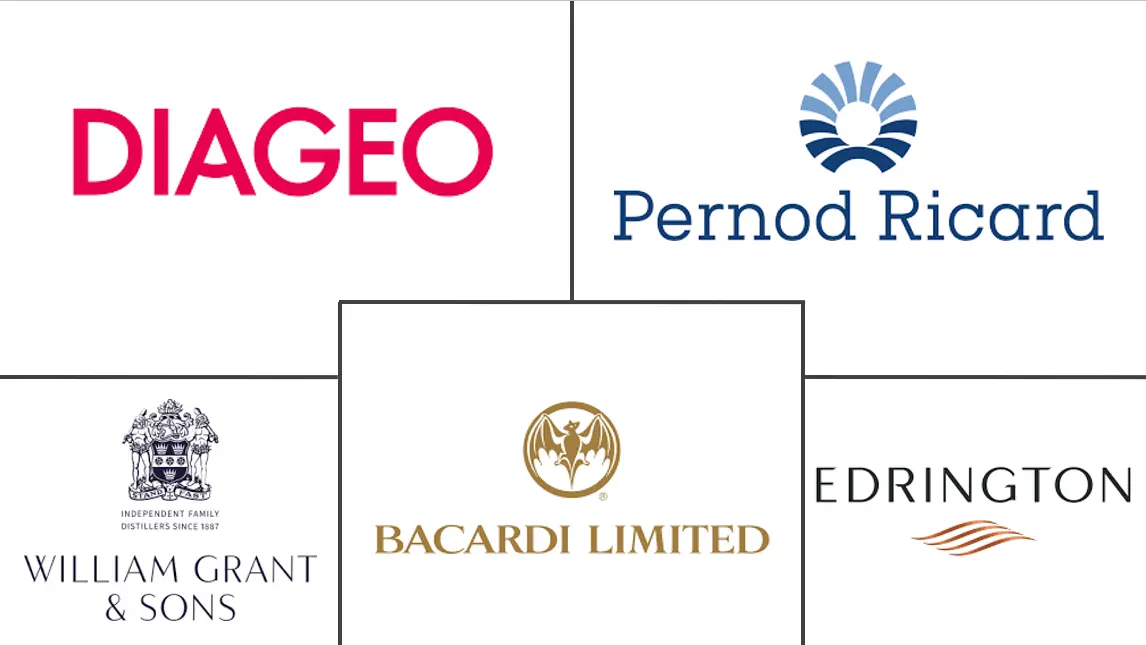Scotch Whisky Market Size and Share
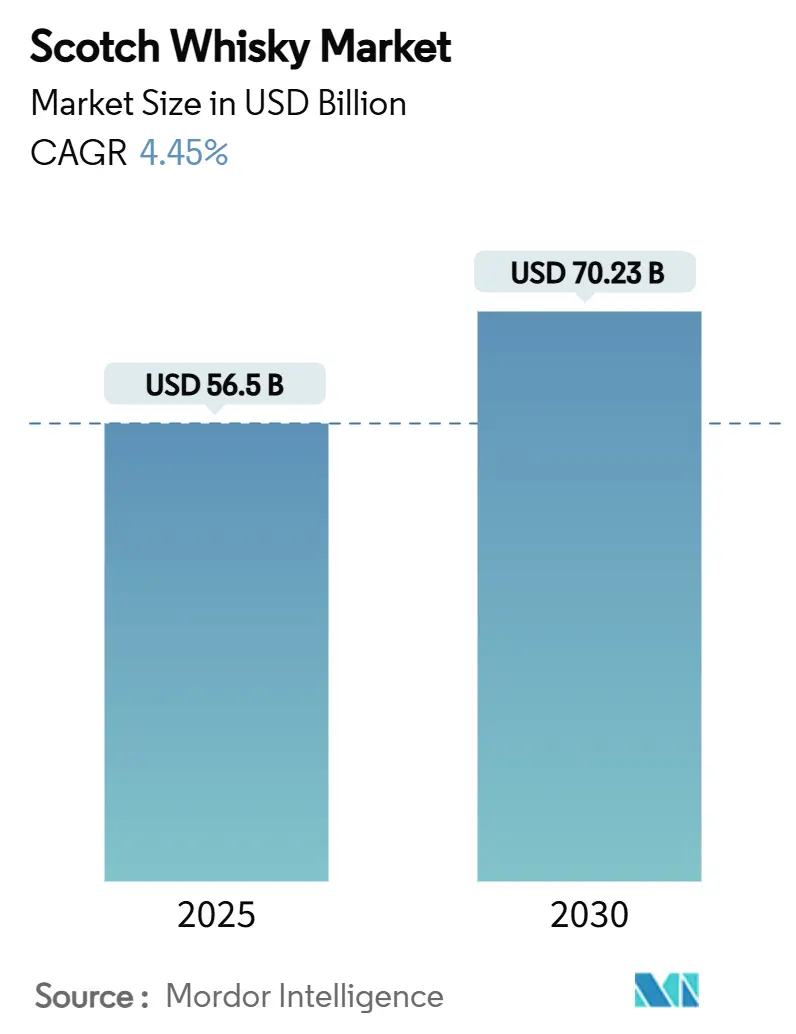
Scotch Whisky Market Analysis by Mordor Intelligence
The global scotch whisky market size is expected to reach USD 56.50 billion in 2025 and grow to USD 70.23 billion by 2030, with a CAGR of 4.45% during the forecast period. The global demand for Scotch whiskey has increased due to growing consumer preference for premium and luxury spirits. Consumers are choosing high-quality, authentic spirits with established heritage, making Scotch whiskey a prominent choice in the premium alcoholic beverages market. This trend is notable in emerging markets, where increased disposable incomes enable consumers to purchase premium spirits. The popularity of whiskey-based cocktails has created new consumption opportunities and attracted younger consumers, especially millennials seeking distinctive drinking experiences.
Key Report Takeaways
- By category, blended Scotch whisky dominated with 59.35% market share in 2024. Single malt Scotch whisky is expected to grow at a 6.51% CAGR through 2030, driven by demand in Asia-Pacific and North America.
- By age statement, 12-15 Years whiskies accounted for 41.22% market share in 2024. Over 30 Years whiskies are projected to grow at a 5.98% CAGR through 2030, particularly in Europe and developed Asian markets.
- By price tier, standard products maintained 48.74% revenue share in 2024. Luxury segment growth is anticipated at 6.66% CAGR during 2025-2030, primarily through travel retail and private client sales.
- By distribution channel, off-trade outlets accounted for 62.65% of sales in 2024. Travel retail/duty-free is projected to grow at 5.78% CAGR, supported by recovering tourism and premium product focus.
- By geography, Asia-Pacific represented 31.86% of market value in 2024. The Middle East and Africa region is expected to grow at 6.25% CAGR through 2030, driven by new consumer entry into the spirits market.
Global Scotch Whisky Market Trends and Insights
Drivers Impact Analysis
| Driver | (~) % Impact on CAGR Forecast | Geographic Relevance | Impact Timeline |
|---|---|---|---|
| Premiumization and luxury positioning | +1.2% | Global, with concentration in North America, Europe, Asia-Pacific | Medium term (2-4 years) |
| Rising demand for single malt and craft expressions | +0.8% | Global, particularly strong in Asia-Pacific and North America | Long term (≥ 4 years) |
| Expansion of e-commerce and DTC logistics | +0.5% | Global, with early adoption in North America and Europe | Short term (≤ 2 years) |
| Product innovation and flavors | +0.4% | Global, with focus on developed markets | Medium term (2-4 years) |
| Whisky tourism and experiential offerings | +0.3% | Scotland, with spillover to global markets | Long term (≥ 4 years) |
| Influence of cocktail culture and on-premise trends | +0.2% | North America, Europe, Asia-Pacific urban centers | Medium term (2-4 years) |
| Source: Mordor Intelligence | |||
Premiumization and luxury positioning
The Scotch whisky industry is undergoing a transformation through strategic luxury positioning, as companies create specialized luxury divisions to pursue high-margin opportunities. Diageo exemplified this approach by establishing the Diageo Luxury Group in November 2024, consolidating spirits priced above USD 100 under one strategic unit. This restructuring allows targeted investment in ultra-premium offerings, including Johnnie Walker's Vault, which provides custom blending services starting at GBP 50,000. The luxury market has expanded beyond traditional consumption into investment opportunities, particularly through whisky cask ownership. The premium spirits segment's potential is demonstrated by American whiskey market data, where high-end and premium brands recorded 274% revenue growth since 2003, while super-premium brands grew by 2,150%[1]Source: Distilled Spirits Council, “American Whiskey Category Fact Sheet” distilledspirits.org. This shift toward premium offerings helps companies offset regulatory costs while building long-term value in wealthy consumer segments.
Rising demand for single malt and craft expressions
The single malt Scotch whisky category has experienced rapid growth, driven by consumers seeking authentic, craft-produced spirits. In Asia-Pacific markets, younger urban consumers increasingly prefer whisky over traditional spirits like baijiu, reflecting a significant shift in consumption patterns. Production capacity expansion has become essential to meet the rising demand, exemplified by Brown-Forman's GBP 30 million investment in The GlenDronach Distillery. This investment aims to double the facility's output, following a substantial threefold increase in global demand since 2016. The growth in single malt whisky consumption is further strengthened by collector interest and investment opportunities.
Expansion of e-commerce and DTC logistics
Digital commerce is transforming direct-to-consumer relationships in the scotch whisky market, enabling companies to increase profit margins while building customer databases. Diageo implemented this approach through its FlavorPrintConnect technology on Malts.com, which combines physical whisky tasting kits with AI-powered digital masterclasses for personalized customer experiences. The UK's revised alcohol duty system, introducing digital approval processes and unified digital returns in March 2025, supports e-commerce channel expansion[2]Source: GOV.UK, "Draft regulations: The Alcoholic Products (Excise Duty) (Amendment) Regulations 2024," gov.uk. In markets with complex distribution networks, direct-to-consumer models help companies maintain price control and direct customer relationships. Companies are implementing blockchain and AI-powered verification systems for product authentication to prevent counterfeiting. The e-commerce channel continues to grow as consumers, especially younger demographics, seek convenient and personalized experiences through digital platforms and subscription services.
Product innovation and flavors
Product development in the spirits market focuses on differentiation through technological advancement and unique consumer experiences. Johnnie Walker demonstrated this by collaborating with artist Andy Gellenberg to create 5,000 AI-generated bottle designs, enhancing product personalization and collectibility. The industry's commitment to sustainability is evident in packaging innovations, exemplified by Johnnie Walker's Blue Label Ultra, which achieved a milestone as the world's lightest 70cl Scotch whisky glass bottle at 180g after five years of research aimed at reducing carbon emissions. Companies are also innovating in production processes, implementing renewable energy solutions while maintaining product quality. These strategies align with consumer preferences for authentic experiences and environmental responsibility, strengthening brands' market positions.
Restraints Impact Analysis
| Restraint | (~) % Impact on CAGR Forecast | Geographic Relevance | Impact Timeline |
|---|---|---|---|
| Volatile excise duties and trade tariffs | -0.9% | Global, with particular impact on UK-US and UK-India trade | Short term (≤ 2 years) |
| Competition from other spirits | -0.6% | Global, with intensity varying by region | Medium term (2-4 years) |
| Counterfeiting and Illicit Trade | -0.4% | Global, with concentration in emerging markets | Long term (≥ 4 years) |
| Environmental and sustainability pressures | -0.3% | Global, with stricter requirements in developed markets | Long term (≥ 4 years) |
| Source: Mordor Intelligence | |||
Volatile excise duties and trade tariffs
The Scotch whiskey market faces significant regulatory challenges, primarily through tax policy changes that affect consumer pricing and demand. The United Kingdom's recent double-digit tax increase on Scotch whisky led to decreased sales volumes and resulted in daily revenue losses of over GBP 500,000 for the United Kingdom Exchequer[3]Source: The Scotch Whisky Association, "Treasury has lost half a million pounds a day since double digit tax hike on Scotch," scotch-whisky.org.uk. The potential reimposition of 25% United States tariffs on Scotch whisky within 18 months creates additional uncertainty for the industry's primary export market. However, the UK-India Free Trade Agreement presents growth opportunities by reducing import duties from 150% to 75% initially, followed by a further reduction to 40% over ten years. Companies are responding to these regulatory uncertainties by implementing adaptable pricing strategies and expanding their market presence across multiple regions.
Competition from other spirits
The spirits market's fragmentation intensifies competition for consumer spending across gin, vodka, and rum categories, with companies using product innovation and marketing to gain market share. Competition is strong in the cocktail segment, where both bartenders and consumers experiment with various spirits, which may reduce whisky's prominence in premium mixed drinks. Regional preferences present additional challenges, as local spirits maintain cultural significance that imported Scotch whisky must address. The market dynamics are further shaped by the growth of local whisky production in key markets, particularly in India and Japan, where domestic distilleries create products that align with national identity and local tastes.
Segment Analysis
By Category: Single Malt Drives Premium Evolution
Blended Scotch Whisky commands 59.35% of the market share in 2024, maintaining its dominant position through its extensive distribution networks, competitive pricing strategies, and established consumer loyalty. The category's strength lies in its ability to offer consistent quality across various price points, from entry-level to premium expressions, making it accessible to a diverse consumer base across global markets. Single malt Scotch whisky is projected to grow at a 6.51% CAGR during 2025-2030, driven by increasing consumer sophistication and willingness to explore premium offerings. This growth is supported by substantial investments in production capacity, aging facilities, and specialized distillation processes, enabling distilleries to meet the rising demand for high-quality single malt expressions.
Single grain Scotch whisky holds a distinctive position in the spirits industry, primarily serving as a crucial component in blended whisky expressions. There's a growing consumer awareness and appreciation for the craftsmanship involved in whisky production, leading to increased interest in various whisky categories, including Single Grain Scotch. The market is also benefiting from the premiumization trend, where consumers demonstrate a willingness to invest in authentic, high-quality spirits. The segment's growth is further supported by its versatility in blending, making it an essential ingredient for master blenders creating premium blended Scotch whiskies.

Note: Segment shares of all individual segments available upon report purchase
By Age Statement: Ultra-Premium Maturation Commands Growth
The 12-15 Years age statement segment holds a dominant 41.22% market share in 2024, balancing accessibility and premium positioning to attract both experienced consumers and those moving up from younger expressions. This category maintains stable supply through established production cycles and effective inventory management, enabling consistent market availability to meet consumer demand. The Below 12 Years category functions as an entry point for new consumers and price-sensitive buyers, while the 16-20 Years segment targets dedicated enthusiasts seeking extended maturation profiles. The 21-30 Years category focuses on collectors and special occasion purchases, with limited availability supporting premium pricing.
The Over 30 Years segment is projected to achieve a 5.98% CAGR during 2025-2030, primarily due to investment demand and collector interest in rare expressions. The growth in this segment demonstrates whisky's emergence as an alternative investment asset, though investors face potential risks due to regulatory uncertainties in cask ownership. The age statement segmentation distribution reflects historical production limitations, prompting companies to increase production capacity to address future demand for aged expressions.
By Price Tier: Luxury Segment Accelerates Despite Challenges
Standard price tier products hold the largest market share at 48.74% in 2024, forming the core volume base for most brands and providing entry-level options for new consumers. This segment experiences a significant impact from excise duty increases. Premium products occupy the mid-tier segment, combining quality offerings with moderate pricing and benefiting from consumer trade-up behavior. Premium segment growth differs across regions, with developed markets showing stronger premiumization compared to emerging markets, where price sensitivity remains a key factor.
The luxury segment is expected to grow at a CAGR of 6.66% during 2025-2030, supported by ultra-premium positioning and experiential offerings that command higher prices. The segment demonstrates resilience as affluent consumers maintain their spending patterns despite economic fluctuations. While the luxury segment has effectively differentiated itself from standard products, it must continuously innovate to preserve its exclusivity and maintain premium price points.
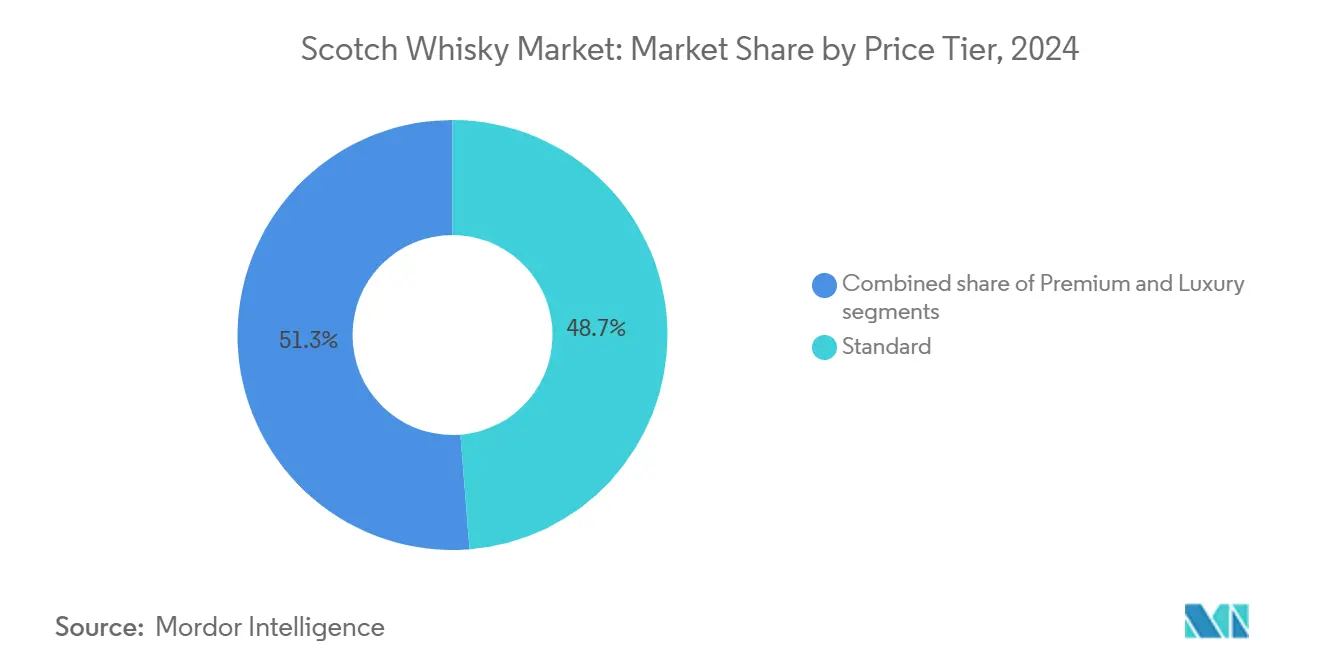
Note: Segment shares of all individual segments available upon report purchase
By Distribution Channel: Travel Retail Rebounds Strongly
Off-trade channels hold a dominant 62.65% market share in 2024, primarily through retail outlets such as supermarkets, liquor stores, and others. This dominance stems from consumer preferences for home consumption and the convenience of purchasing whisky alongside regular grocery shopping. The off-trade segment leverages promotional activities, including seasonal discounts and bundle offers, while also developing private label opportunities through retailer-specific brands. Additionally, on-trade channels, comprising bars, restaurants, and hotels, facilitate experiential consumption through cocktail offerings and premium whisky tastings, while serving as crucial platforms for introducing new products to consumers. The performance of on-trade distribution closely aligns with hospitality industry trends and social dining behaviors.
The travel retail/duty-free channel is projected to grow at a CAGR of 5.78% during 2025-2030, driven by the recovery in international travel and consumer preference for premium products. The channel benefits from travelers' willingness to purchase authentic Scottish products at higher price points, enabling better profit margins and brand development opportunities. The integration of digital services, such as pre-ordering and collection facilities, improves the shopping experience. The channel demonstrates resilience through its adaptation to evolving travel patterns and consumer preferences.
Geography Analysis
Asia-Pacific holds the largest market share at 31.86% in 2024, primarily due to China's expanding whisky market. The region's market position stems from increasing disposable incomes, rapid urbanization, and evolving consumer preferences toward Western spirits. Japan's mature whisky market creates a natural pathway for Scotch whisky adoption, while India presents substantial growth opportunities despite existing tariff restrictions. Australia and South Korea maintain consistent demand, and emerging economies such as Indonesia and Thailand demonstrate growth potential as their markets develop.
The Middle East and Africa region is projected to grow at 6.25% CAGR during 2025-2030, supported by middle-class population growth and enhanced distribution networks. The region's expansion reflects economic progress and evolving attitudes toward alcohol consumption in markets where it is permitted. South Africa dominates regional consumption, while the United Arab Emirates functions as the primary distribution center for the Middle East. In addition, South America demonstrates consistent growth prospects, with Brazil's large consumer base and strengthening economy driving the market, while Argentina and Chile develop premium market segments.
Europe remains a key market for Scotch whisky due to its historical significance, established consumer base, and cultural affinity for aged spirits. The region's traditional appreciation for Scotch whisky is evident through its extensive distribution networks, premium positioning in retail outlets, and strong presence in both on-trade and off-trade channels. European consumers demonstrate sophisticated preferences for single malts and aged blends, supported by well-established tasting clubs and whisky societies. However, the region faces regulatory challenges, including changes in labeling requirements, taxation policies, and trade agreements that impact market dynamics.
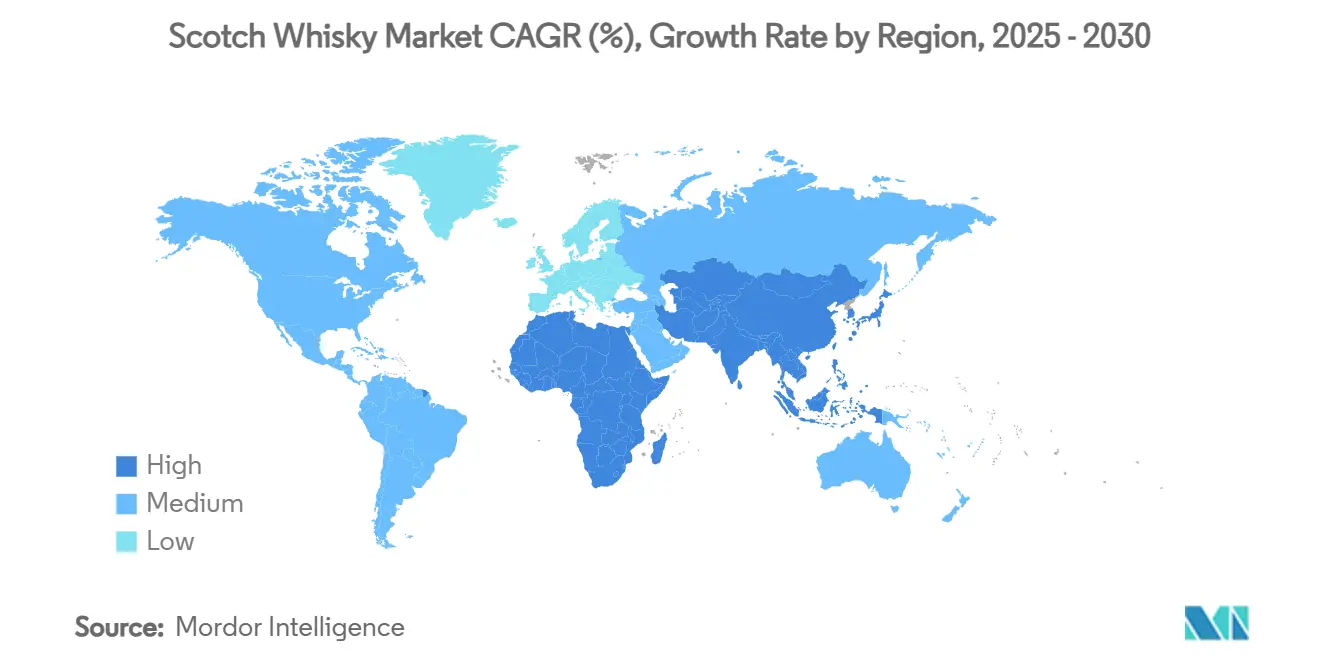
Competitive Landscape
The Scotch whisky market exhibits moderate concentration with a score of 7 out of 10, indicating significant consolidation opportunities while maintaining competitive dynamics. Leading players pursue premiumization strategies through luxury positioning and experiential offerings. Strategic moves focus on capacity expansion and geographic diversification, with companies investing heavily in production facilities to meet growing demand for premium expressions.
Technology integration emerges as a key differentiator, with companies leveraging AI and digital platforms to enhance consumer experiences and operational efficiency. Innovation extends to sustainability initiatives, with manufacturers investing in renewable energy and lightweight packaging to address environmental pressures while maintaining product quality.
White-space opportunities exist in emerging markets and direct-to-consumer channels, where regulatory changes enable new business models. The competitive landscape reflects a balance between established heritage brands and innovative approaches to consumer engagement, with success requiring both authenticity and adaptability to changing market conditions.
Scotch Whisky Industry Leaders
-
Diageo plc
-
Pernod Ricard SA
-
Bacardi Ltd
-
William Grant & Sons Ltd
-
Edrington Group
- *Disclaimer: Major Players sorted in no particular order
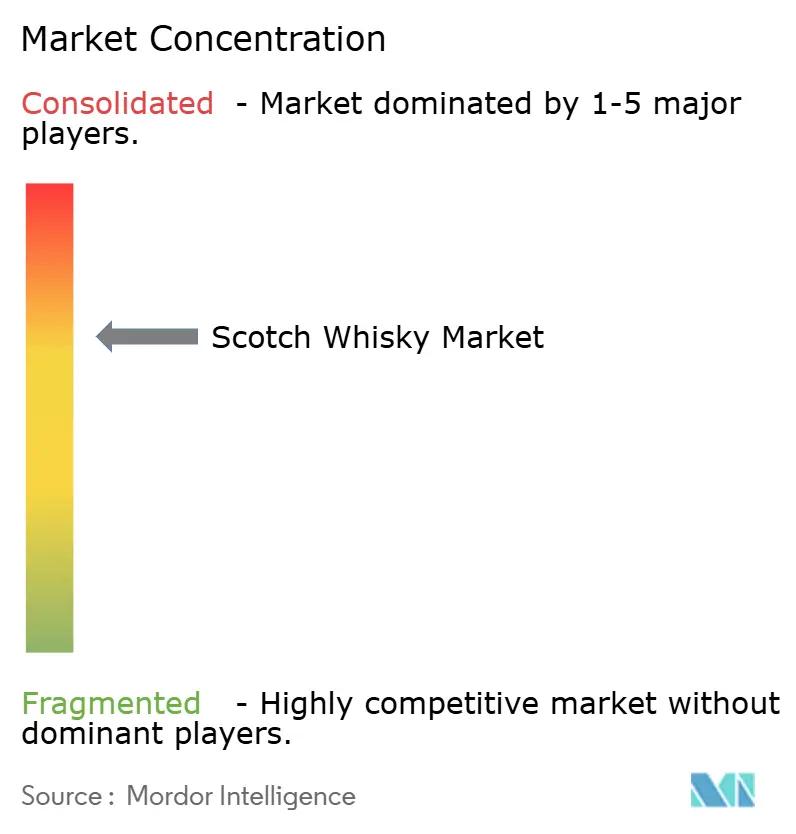
Recent Industry Developments
- July 2025: William Grant's acquired The Famous Grouse and Naked Malt, marking a significant consolidation move in the blended Scotch whisky segment. This acquisition strengthens William Grant's portfolio and market position in the competitive blended category.
- March 2025: Johnnie Walker launched the Vault experience, offering bespoke Scotch whisky blending services starting at GBP 50,000, targeting ultra-high-net-worth individuals seeking personalized luxury experiences. The initiative represents a new frontier in luxury spirits positioning and experiential marketing.
- November 2024: Diageo launched FlavorPrintConnect technology, combining whisky tasting kits with AI-enhanced digital masterclasses to create personalized consumer experiences. The platform reflects innovation in direct-to-consumer engagement and digital marketing.
- October 2024: Johnnie Walker introduced AI-powered bottle designs in collaboration with artist Andy Gellenberg, producing 5,000 unique collectible designs exclusively for the German market. This initiative demonstrates technology integration in product personalization and marketing.
Global Scotch Whisky Market Report Scope
| Single Malt |
| Single Grain |
| Blended Malt |
| Blended Grain |
| Blended |
| Below 12 years |
| 12–15 Years |
| 16–20 Years |
| 21–30 Years |
| Over 30 Years |
| Standard |
| Premium |
| Luxury |
| Off-Trade |
| On-Trade |
| North America | United States |
| Canada | |
| Mexico | |
| Rest of North America | |
| Europe | Germany |
| United Kingdom | |
| Italy | |
| France | |
| Spain | |
| Netherlands | |
| Poland | |
| Belgium | |
| Sweden | |
| Rest of Europe | |
| Asia-Pacific | China |
| India | |
| Japan | |
| Australia | |
| Indonesia | |
| South Korea | |
| Thailand | |
| Singapore | |
| Rest of Asia-Pacific | |
| South America | Brazil |
| Argentina | |
| Colombia | |
| Chile | |
| Peru | |
| Rest of South America | |
| Middle East and Africa | South Africa |
| Saudi Arabia | |
| United Arab Emirates | |
| Nigeria | |
| Egypt | |
| Morocco | |
| Turkey | |
| Rest of Middle East and Africa |
| By Category | Single Malt | |
| Single Grain | ||
| Blended Malt | ||
| Blended Grain | ||
| Blended | ||
| By Age Statement | Below 12 years | |
| 12–15 Years | ||
| 16–20 Years | ||
| 21–30 Years | ||
| Over 30 Years | ||
| By Price Tier | Standard | |
| Premium | ||
| Luxury | ||
| By Distribution Channel | Off-Trade | |
| On-Trade | ||
| By Geography | North America | United States |
| Canada | ||
| Mexico | ||
| Rest of North America | ||
| Europe | Germany | |
| United Kingdom | ||
| Italy | ||
| France | ||
| Spain | ||
| Netherlands | ||
| Poland | ||
| Belgium | ||
| Sweden | ||
| Rest of Europe | ||
| Asia-Pacific | China | |
| India | ||
| Japan | ||
| Australia | ||
| Indonesia | ||
| South Korea | ||
| Thailand | ||
| Singapore | ||
| Rest of Asia-Pacific | ||
| South America | Brazil | |
| Argentina | ||
| Colombia | ||
| Chile | ||
| Peru | ||
| Rest of South America | ||
| Middle East and Africa | South Africa | |
| Saudi Arabia | ||
| United Arab Emirates | ||
| Nigeria | ||
| Egypt | ||
| Morocco | ||
| Turkey | ||
| Rest of Middle East and Africa | ||
Key Questions Answered in the Report
What is the current size and growth outlook for the Scotch whisky market?
The Scotch whisky market is valued at USD 56.50 billion in 2025 and is forecast to climb to USD 70.23 billion by 2030, reflecting a 4.45% CAGR.
Which geographic region leads Scotch whisky sales?
Asia-Pacific leads with 31.86% of global value in 2024, driven mainly by China’s rapid adoption of premium whisky.
What category is growing fastest within Scotch?
Single malt Scotch whisky is expanding at a projected 6.51% CAGR through 2030 as consumers seek authenticity and craft credentials.
How are luxury Scotch whiskies performing?
Luxury scotch whiskies are advancing at 6.66% CAGR, buoyed by experiential offerings like bespoke blending sessions.
Page last updated on:
